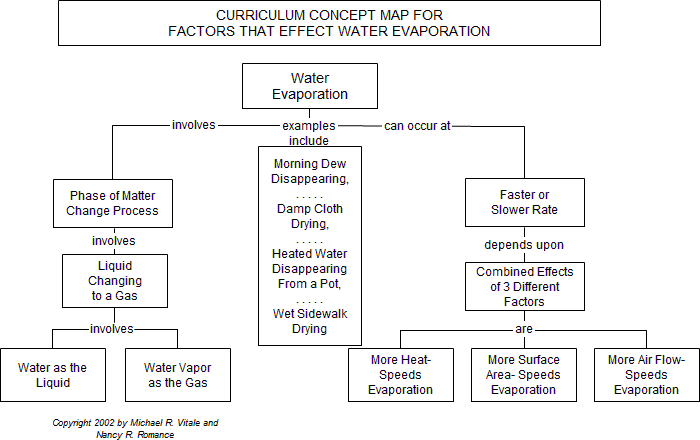

Science IDEAS Elements
Propositional Concept Mapping
Related References
Propositional concept mapping is a key element in the Science IDEAS Model because it focuses on the meaningful organization of conceptual knowledge.
Propositional concept maps all have two important characteristics. First, concepts are arranged hierarchically with core ideas on the top, subordinate ideas below, and examples at the bottom. Second, each concept is linked to at least one other concept in a manner that a concept-link-concept (i.e., noun-verb-noun) forms a simple sentence or proposition that represents a unit of knowledge (see following example).

Examples of concept maps constructed by teachers and/or students can be accessed in the attached reference list. In addition, the teacher resource section of this web-page includes many propositional concept map examples.
An overview of the Propositional Concept Mapping Element follows.
Teacher Preparation to Apply the Propositional Concept Mapping Strategy
Teachers construct a concept map from the material to be used with students
- Teachers identify the key ideas/examples in a text passage (or some other set of content) and writes each on post-it notes.
- Teachers organize ideas/examples in a hierarchical structure (via post-it notes), arranging big ideas on top, sub-ideas below, and examples on bottom.
- Teachers generate links for connecting concepts that are related so each concept-link-concept is in the form of a simple sentence (i.e., noun-verb-noun).
- Teachers review/revise the concept map as necessary.
Classroom Implementation of Propositional Concept Map Construction by Students
Teachers guide students through the same process followed in the planning process.
- Students read passage and then identify key ideas/examples.
- Teachers write and display ideas/examples on post-it notes as students suggest them (all are usually accepted).
- Teachers guide students to identify core ideas (e.g., Which of these ideas are the most general and include others?), subordinate ideas, and examples, arranging the post-it notes in real time to form a hierarchical structure.
- Teachers guide student identification of links that form concept-link-concept (i.e., noun-verb-noun) units.
- Students read the map as if it were prose (editing and re-editing as necessary)
Once students have mastered the process, teachers assign small groups of students to construct and report on propositional concept maps.